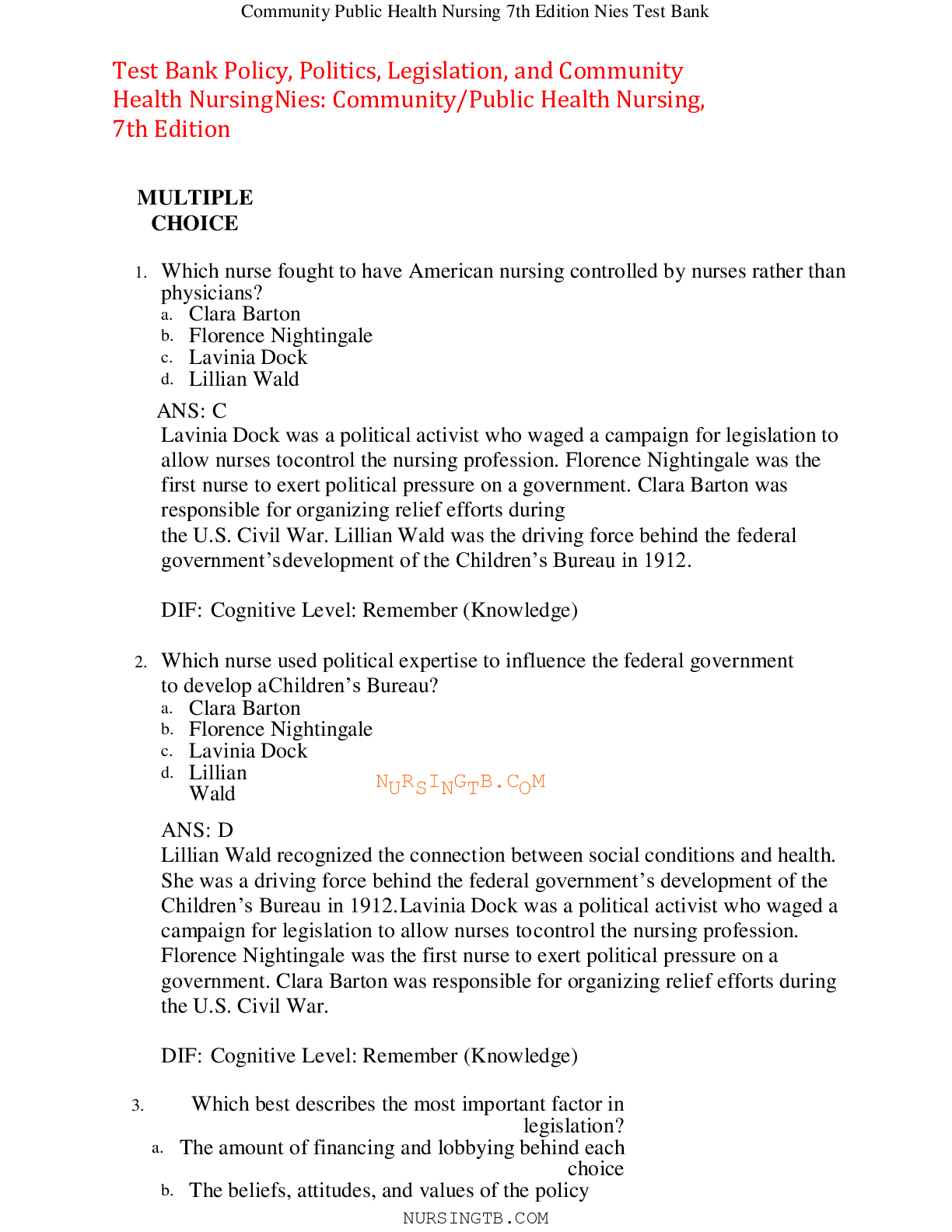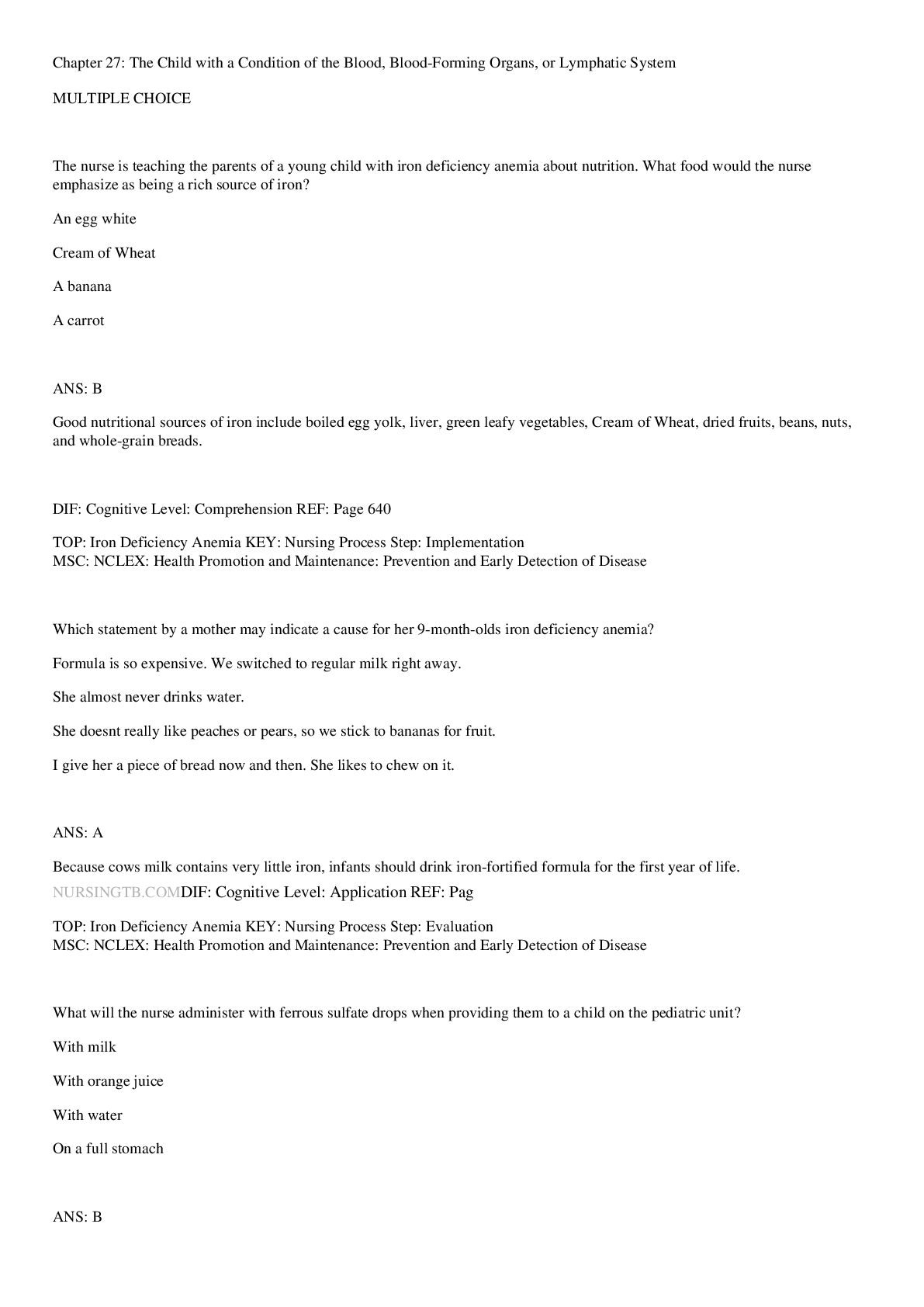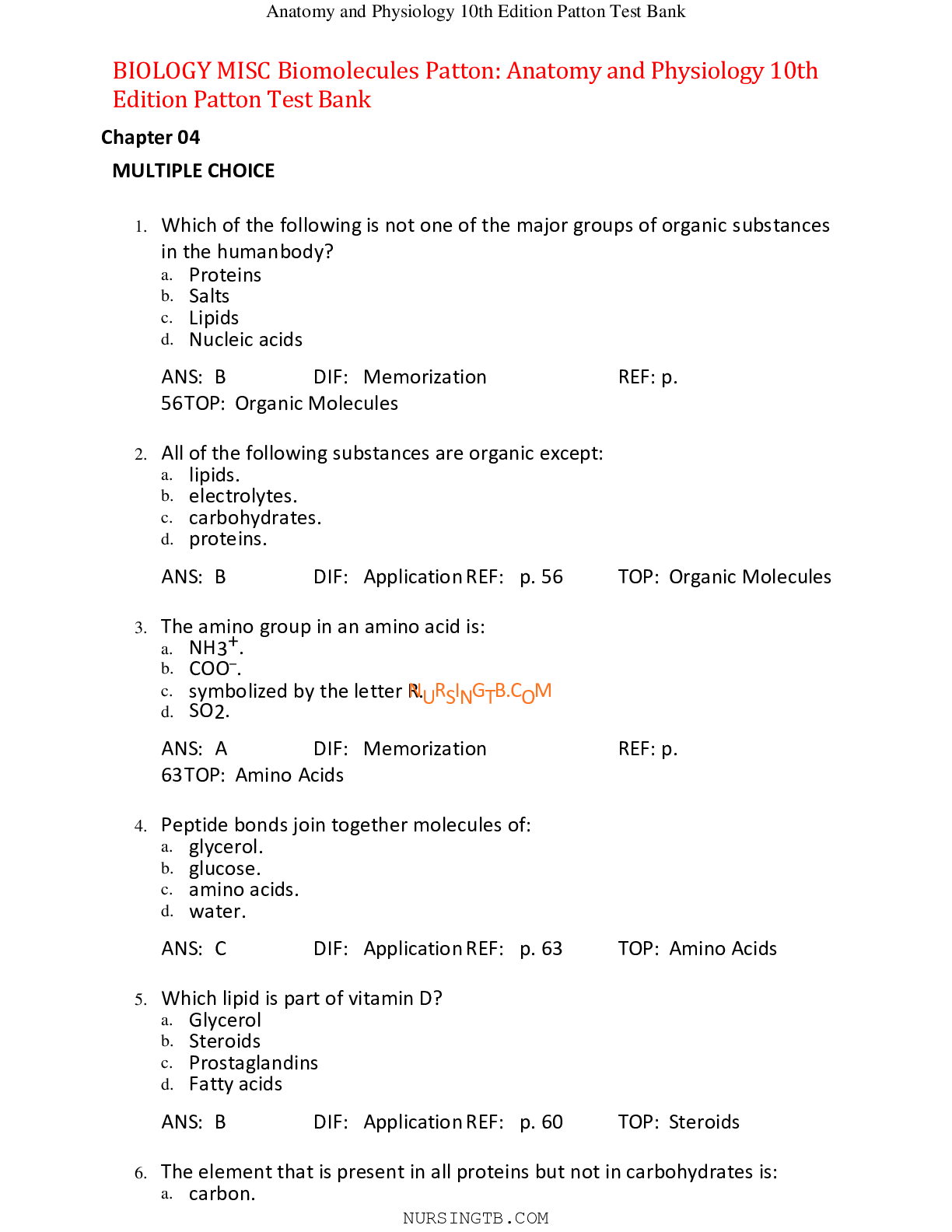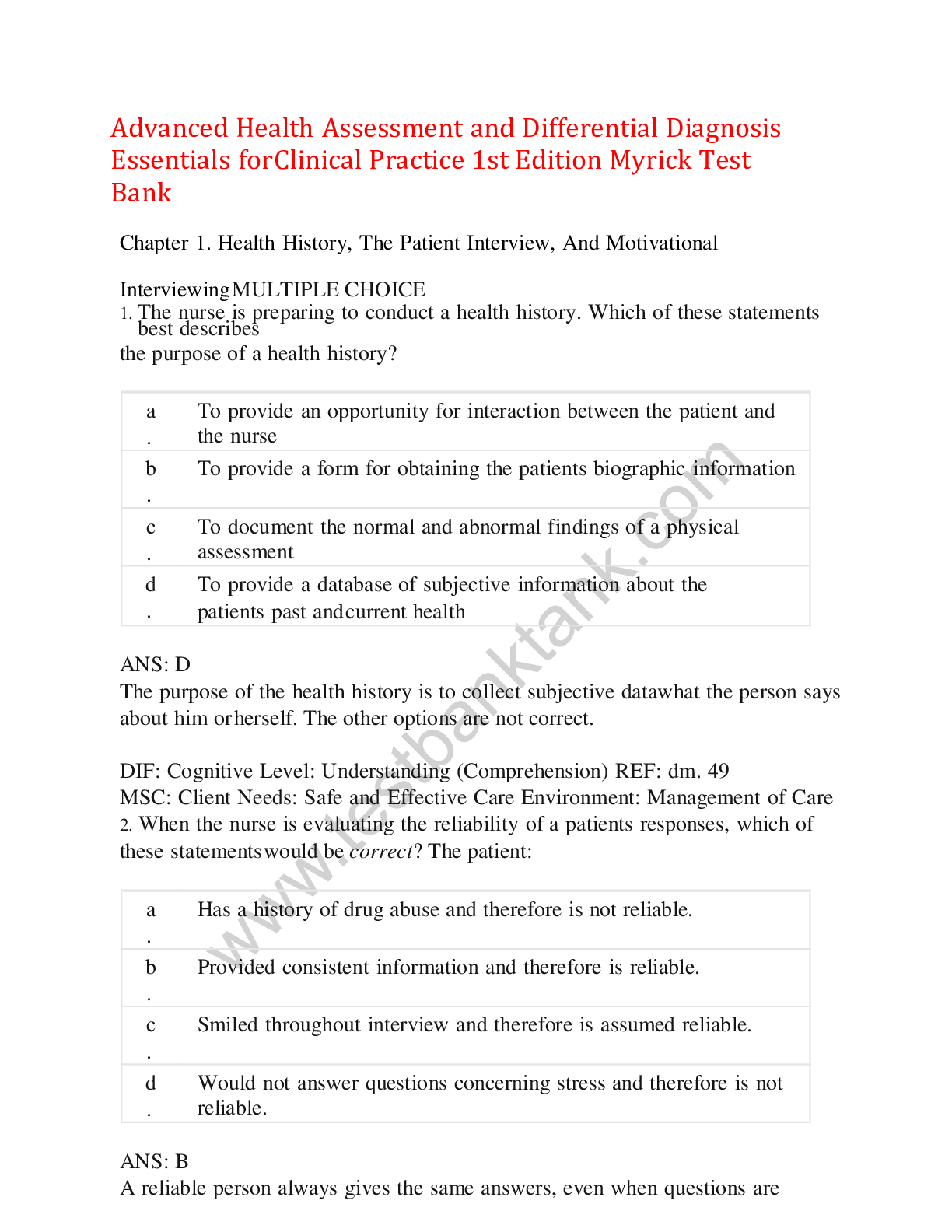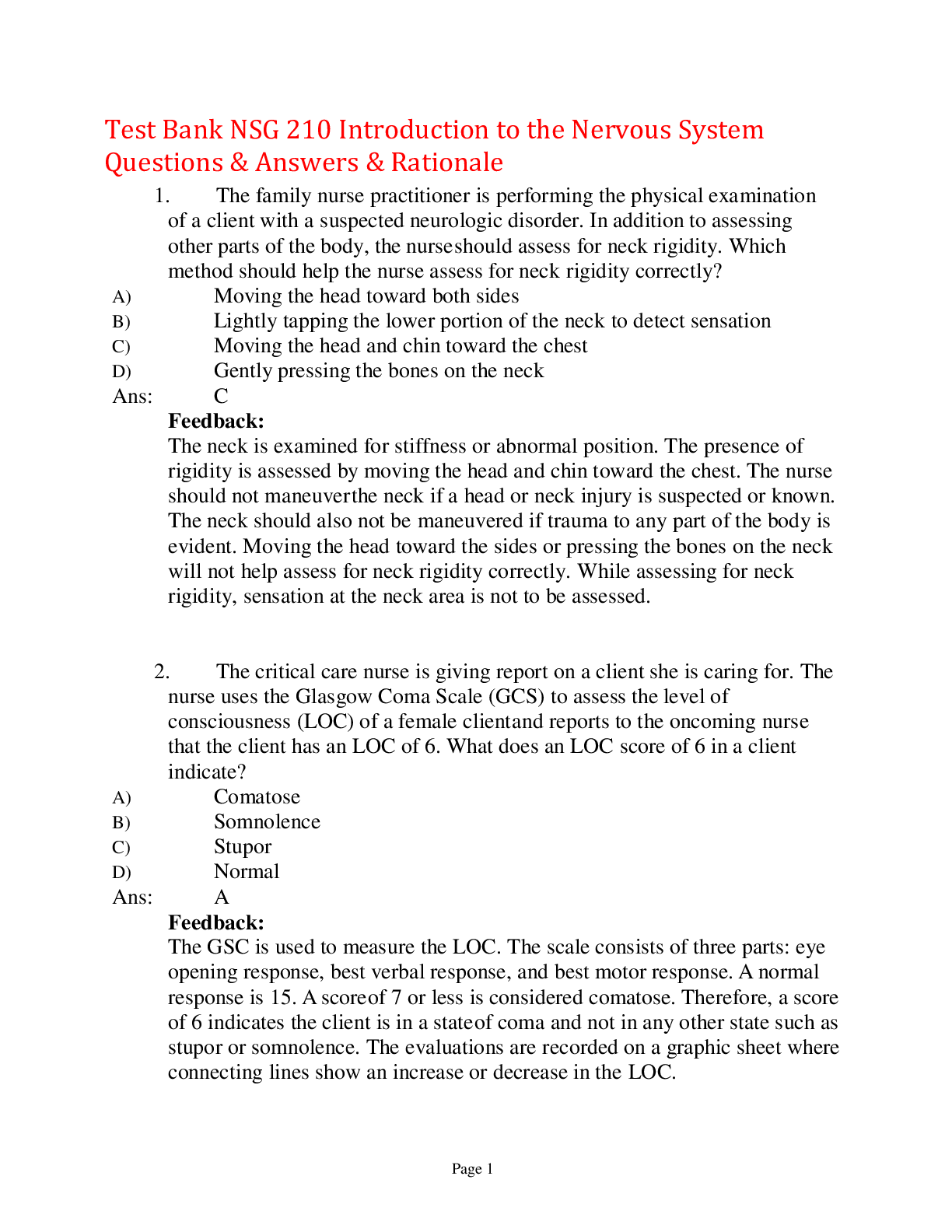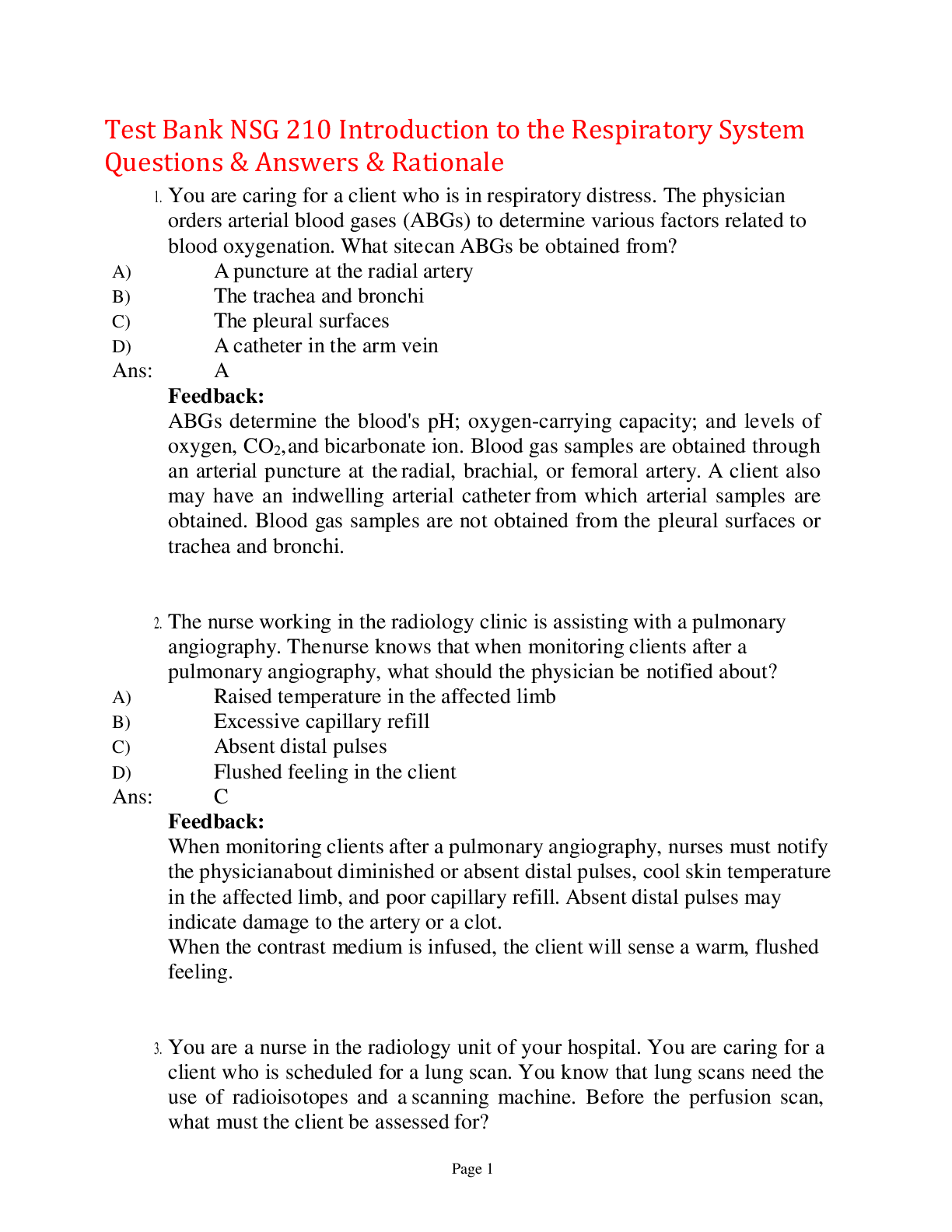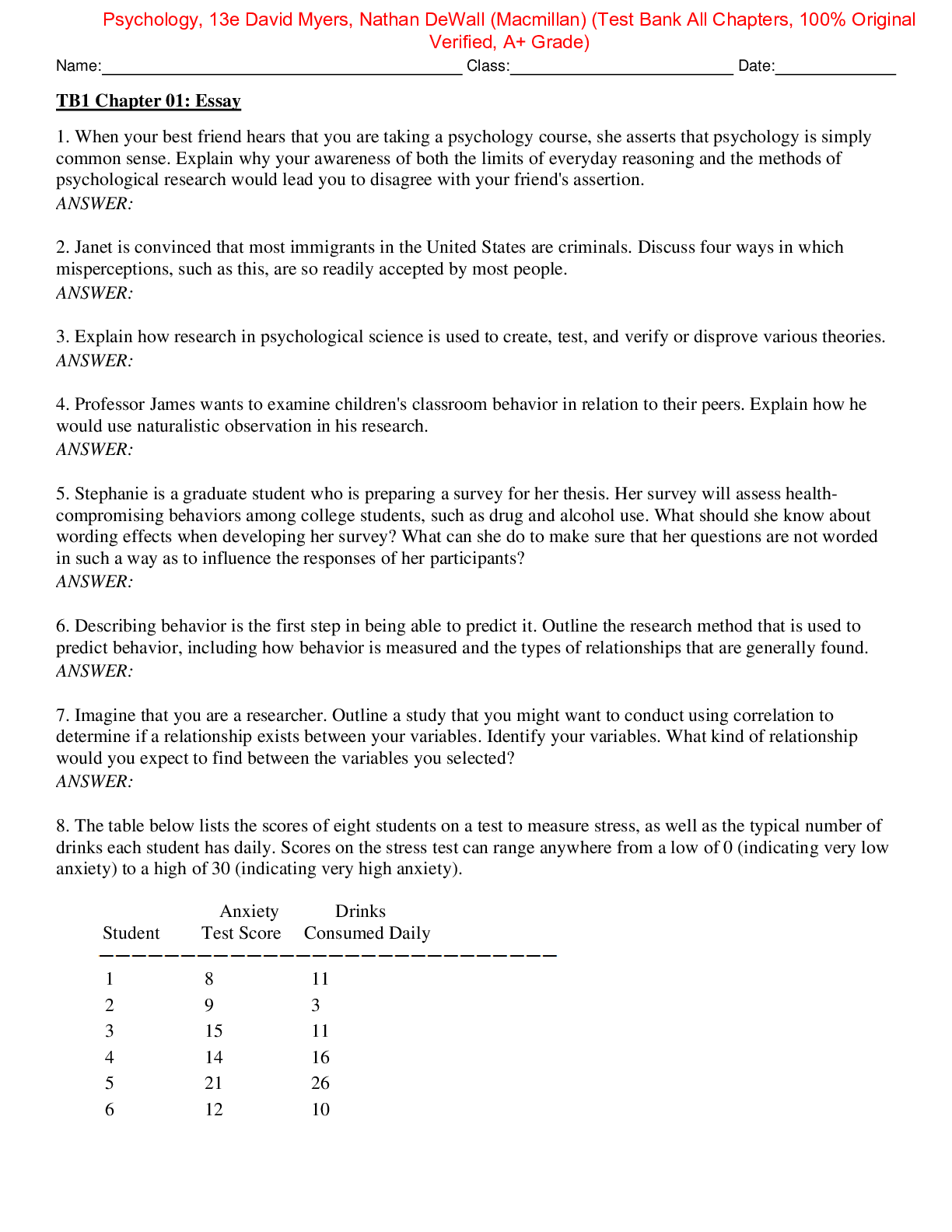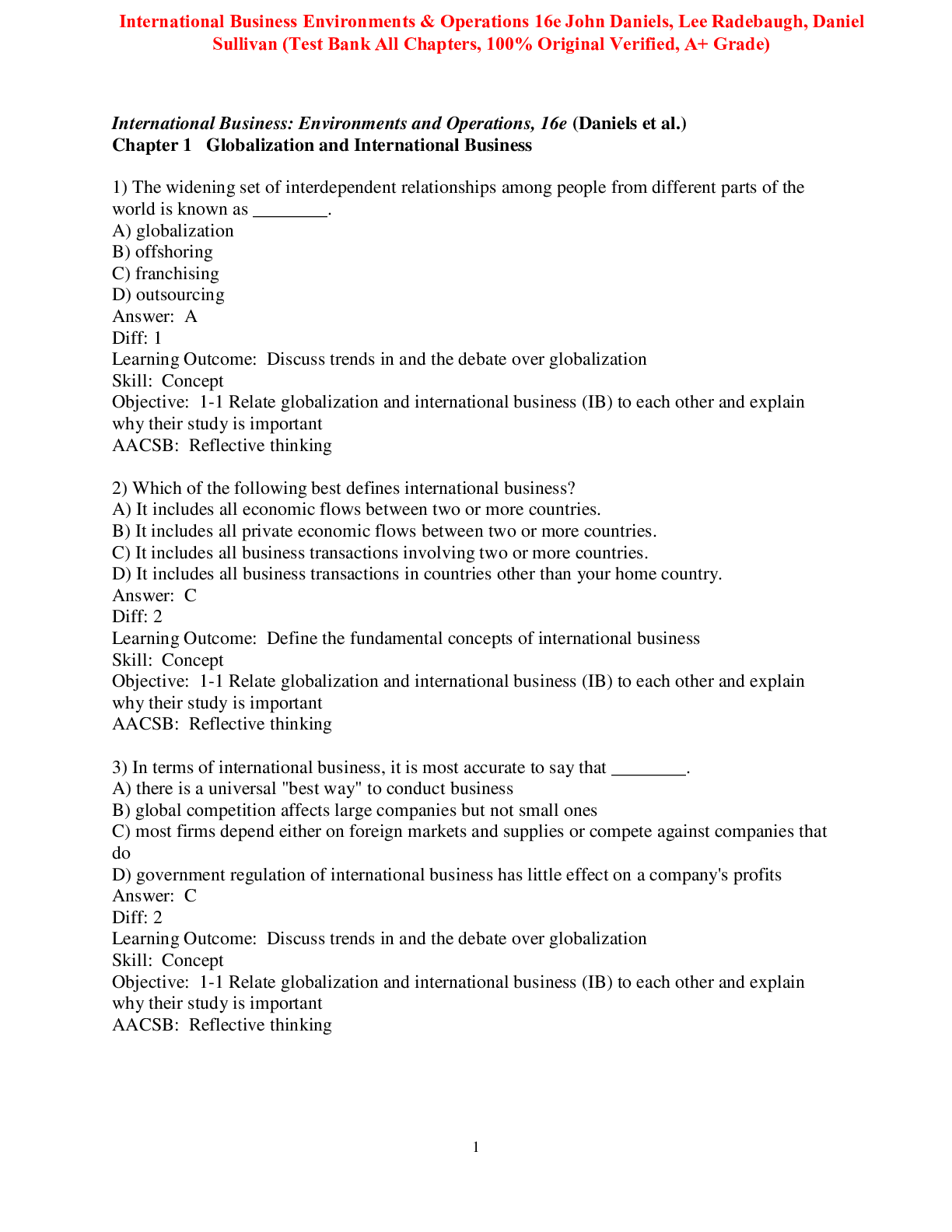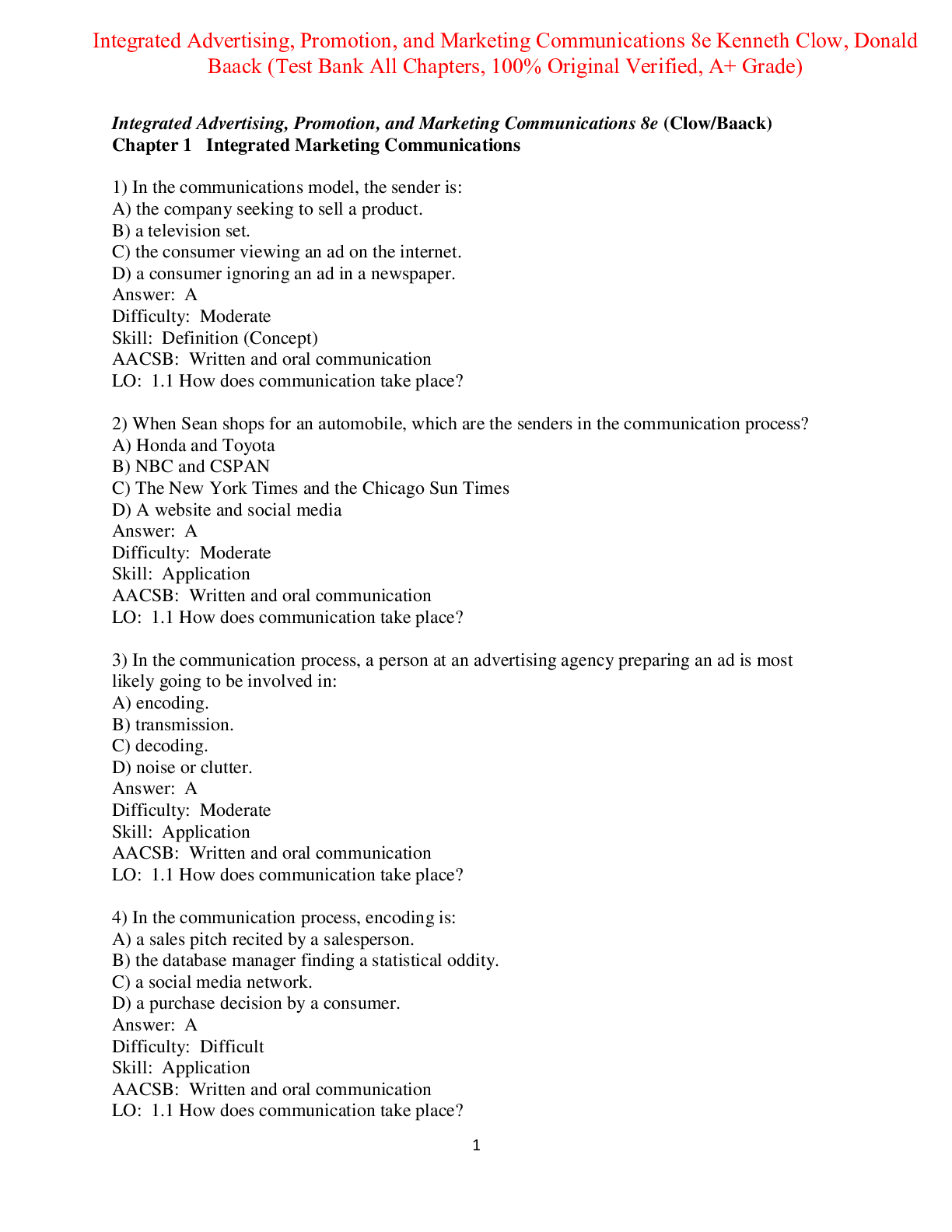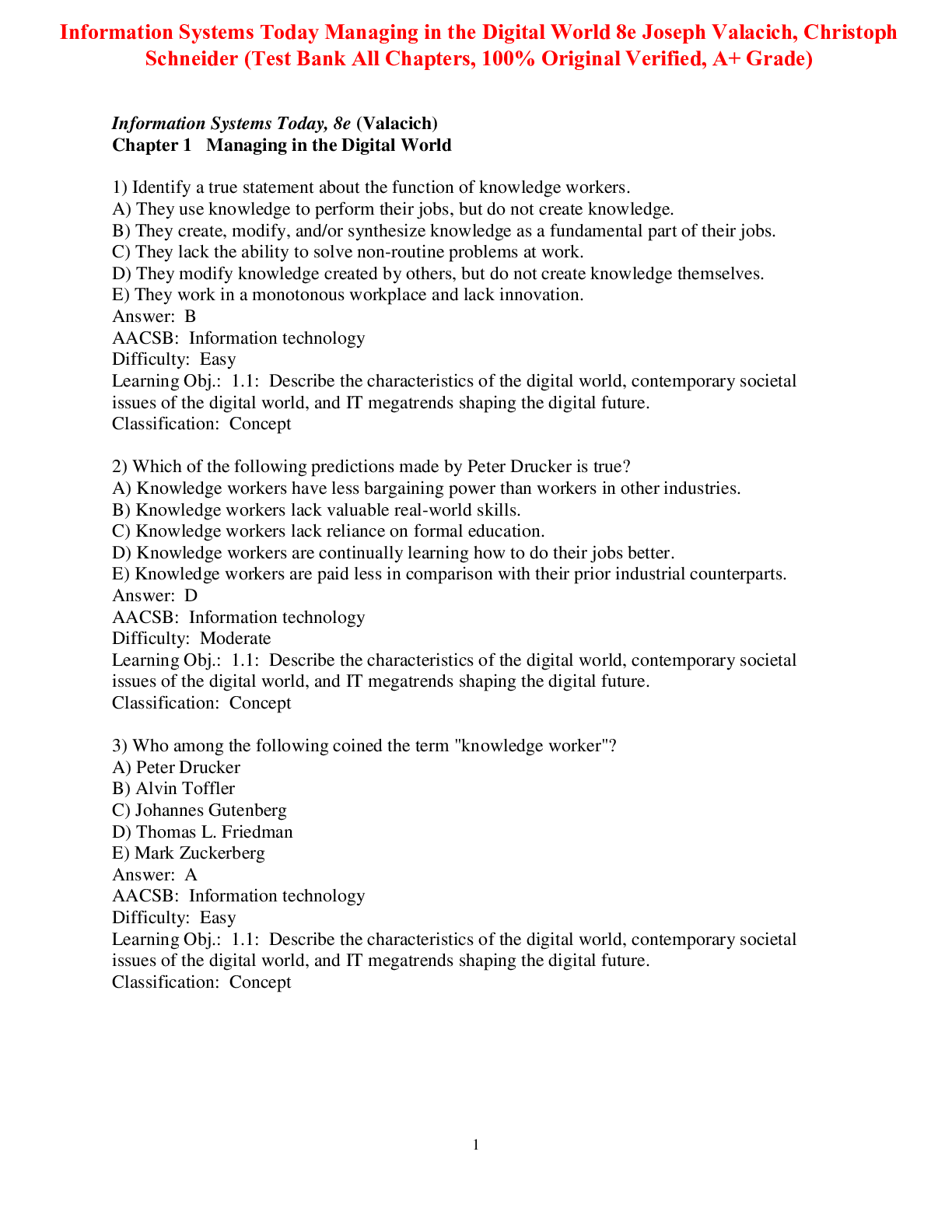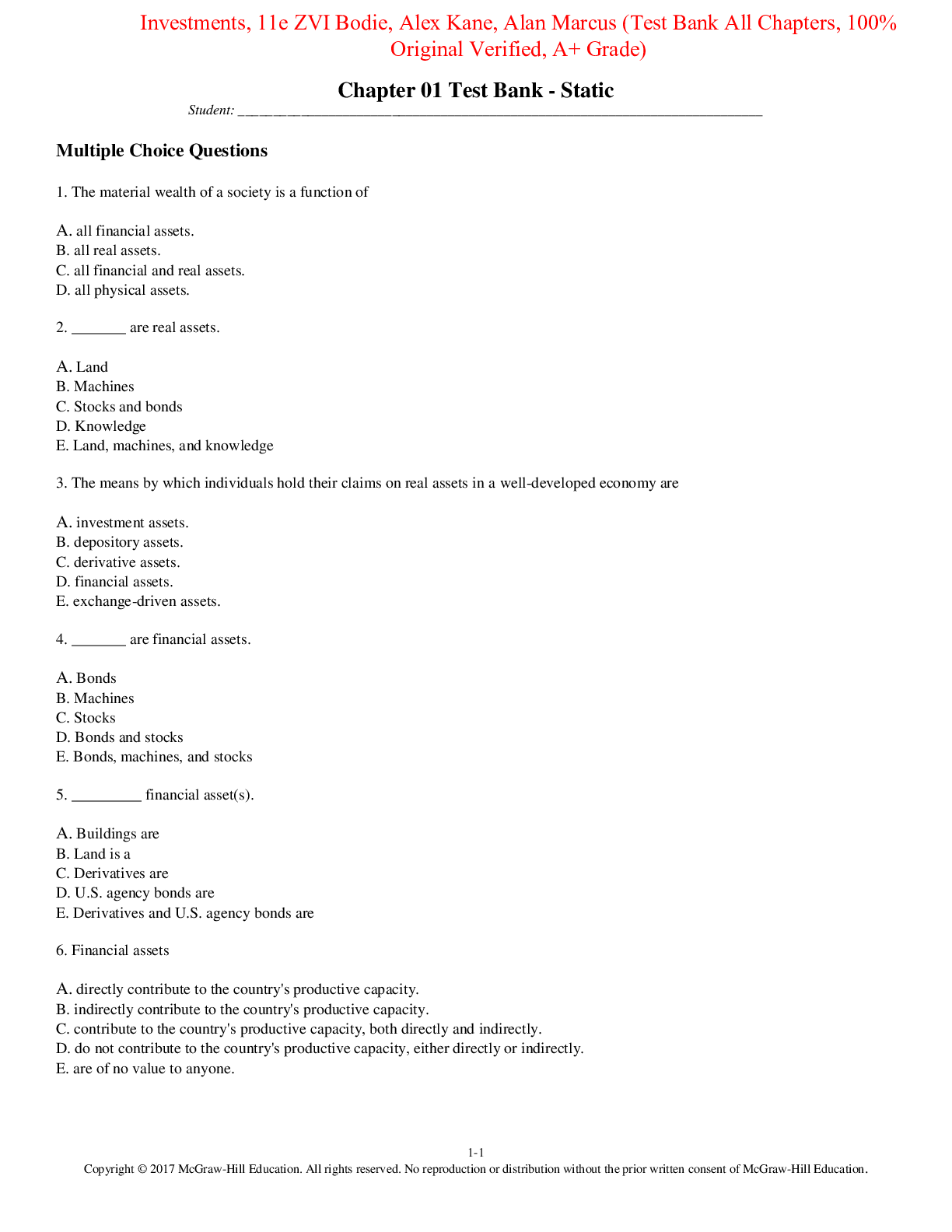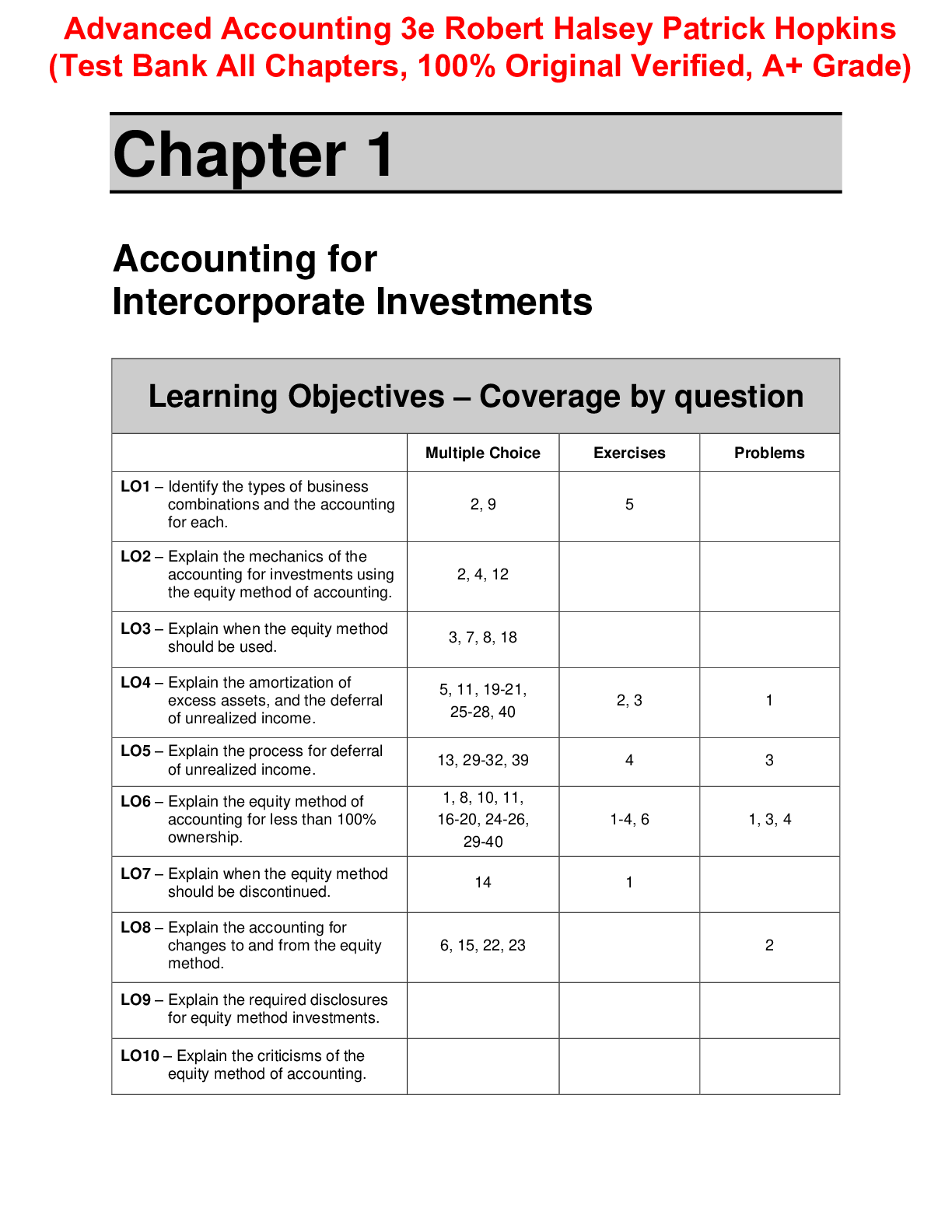*NURSING > TEST BANK > Test Bank NUR 201 Caring for Clients in Shock Questions & Answers & Rationale,100% CORRECT (All)
Test Bank NUR 201 Caring for Clients in Shock Questions & Answers & Rationale,100% CORRECT
Document Content and Description Below
Test Bank NUR 201Caring for Clients in Shock Questions & Answers & Rationale 1. You are the nurse caring for a client in septic shock. You know to closely monitor your client. What finding would yo... u observe when the client's condition is in its initial stages? A) A rapid, bounding pulse B) A slow but steady pulse C) A weak and thready pulse D) A slow and imperceptible pulse Ans: A Feedback: A rapid, bounding pulse is observed in a client in the initial stages of septic shock. In case of hypovolemic shock, the pulse volume becomes weak and thready and circulating volume diminishes in the initial stage. In the later stages when the circulating volume has severely diminished, the pulse becomes slow and imperceptible, and pulse rhythm changes from regular to irregular. 2. You are caring for a client with shock. You are concerned about hypoxemia and metabolic acidosis with your client. What finding should you analyze for evidence of hypoxemia and metabolic acidosis in a client with shock? A) Serum thyroid level findings B) Arterial blood gas (ABG) findings C) Red blood cells (RBCs) and hemoglobin count findings D) White blood cell count findings Ans: B Feedback: Analysis of ABG findings is essential for evidence of hypoxemia and metabolic acidosis. Low RBCs and hemoglobin correlate with hypovolemic shock and can lead to poor oxygenation. An elevated white blood cell count supports septic shock. Serum thyroid level findings do not help determine the presence of hypoxemia or metabolic acidosis. 3. You are the nurse caring for a client with shock accompanied by lung congestion. How would you position this client? A) Completely supine B) Low Fowler's with legs flat C) Supine with lower extremities raised to approximately 45º D) Semi-Fowler's with lower extremities raised to approximately 15º Ans: D Feedback: For a client with shock accompanied by lung congestion, the nurse should raise the client's upper body to approximately 45º and lower extremities to approximately 15º. Elevating the upper body lowers the diaphragm and provides more room for lung expansion and gas exchange. Elevating the head reduces intracranial pressure. Elevating the legs promotes blood perfusion to the heart, lungs, and brain. Therefore, options A, B, and C are incorrect. 4. You are a nursing student preparing to care for an ICU client with shock. Your instructor asks you to name the different categories of shock. Which of the following is a category of shock? A) Hypervolemic B) Distributive C) Restrictive D) Cardiotonic Ans: B Feedback: The four main categories of shock are hypovolemic, distributive, obstructive, and cardiogenic, depending on the cause. This makes options A, C, and D incorrect. 5. You are caring for a client who is in neurogenic shock. You know that this is a subcategory of what kind of shock? A) Obstructive B) Hypovolemic C) Carcinogenic D) Distributive Ans: D Feedback: Three types of distributive shock are neurogenic, septic, and anaphylactic shock. There is no such thing as carcinogenic shock. Obstructive and hypovolemic shock do not have subcategories. 6. You are a student nurse being precepted in the ICU. You are caring for a client in the compensatory stage of shock who is hypovolemic. Which compensatory mechanism is most important in the reabsorption and retention of fluid in the body? A) Activation of renin-angiotensin-aldosterone system B) Secretion of epinephrine and norepinephrine C) Production of antidiuretic hormone and corticosteroid hormones D) Release of catecholamines Ans: C Feedback: Thus, they play an active role in controlling sodium and water balance. Both ADH and corticosteroid hormones, then, promote fluid reabsorption and retention. The renin-angiotensin-aldosterone system is a mechanism that restores blood pressure (BP) when circulating volume is diminished. The release of catecholamines stimulates secretion of epinephrine and norepinephrine. 7. You are assessing a 6-year-old little girl in the emergency department (ED) who was brought in by her mother. She was stung by a bee and is allergic to bee venom. The child is now having trouble breathing. She is vasodilated, hypotensive, and has broken out in hives. What do you suspect is wrong with this child? A) She is having an allergic reaction and going into cardiogenic shock. B) She is having an allergic reaction and going into anaphylactic shock. C) She is having an allergic reaction and going into neurogenic shock. D) She is having an allergic reaction and going into obstructive shock. Ans: B Feedback: Anaphylactic shock is a severe allergic reaction that follows exposure to a substance to which a person is extremely sensitive (see Ch. 34). Common allergic substances include bee venom, latex, fish, nuts, and penicillin. The body's immune response to the allergic substance causes mast cells in the connective tissues, bronchi, and gastrointestinal tract to release histamine and other chemicals. The results are vasodilatation, increased capillary permeability accompanied by swelling of the airway and subcutaneous tissues, hypotension, and hives or an itchy rash. Cardiogenic shock, neurogenic shock, and obstructive shock would not begin with vasodilation, swelling of the airway, and hives. Therefore, options A, C, and D are incorrect. 8. You are caring for a client in the compensation stage of shock. You know that one of the body's mechanisms of compensation in this stage of shock is the renin-angiotensin-aldosterone system. What does this system do? A) Decreases peripheral blood flow B) Increases catecholamine secretion C) Increases the production of antidiuretic hormone D) Restores blood pressure Ans: D Feedback: The renin-angiotensin-aldosterone system is a mechanism that restores blood pressure (BP) when circulating volume is diminished. It does not decrease peripheral blood flow, increase catecholamine secretion, or increase the production of antidiuretic hormone. 9. You are caring for a client in shock who is deteriorating. You are infusing IV fluids and giving medications as ordered. What type of medications are you most likely giving to this client? A) Hormone antagonist drugs B) Antimetabolite drugs C) Adrenergic drugs D) Anticholinergic drugs Ans: C Feedback: Adrenergic drugs are the main medications used to treat shock. This makes options A, B, and D incorrect. 10.A patient presents to the ED in shock. At what point in shock does the nurse know that metabolic acidosis is going to occur? A) Compensation B) Irreversible C) Early D) Decompensation Ans: D Feedback: The decompensation stage occurs as compensatory mechanisms fail. The client's condition spirals into cellular hypoxia, coagulation defects, and cardiovascular changes. As the energy supply falls below the demand, pyruvic and lactic acids increase, causing metabolic acidosis. Therefore, options A, B, and C are incorrect. 11. The nurse is caring for a motor vehicle accident client who is unresponsive on arrival to the emergency department. The client has numerous fractures, internal abdominal injuries, and large lacerations on the head and torso. The family arrives and seeks update on the client's condition. A family member asks, “What causes the body to go into shock?” Given the client's condition, which statement is most correct? A) “The client is in shock because the blood volume has decreased in the system.” B) “The client is in shock because the heart is unable to circulate the body fluids.” C) “The client is in shock because your loved one is not responding and brain dead.” D) “The client is in shock because all peripheral blood vessels have massively dilated.” Ans: A Feedback: Shock is a life-threatening condition that occurs when arterial blood flow and oxygen delivery to tissues and cells are inadequate. Hypovolemic shock, where the volume of extracellular fluid is significantly diminished due to the loss of or reduced blood or plasma, frequently occurs with accidents. 12. The nurse is evaluating a client in the intensive care unit to identify improvement in the client's condition. Which outcome does the nurse note as the result of inadequate compensatory mechanisms? A) Liver dysfunction B) Organ damage C) Weight loss D) Unsteady gait Ans: B Feedback: When the body is unable to counteract the effects of shock, further system failure occurs, leading to organ damage and ultimately death. Liver dysfunction may occur as one of the organs which fail. Weight fluctuations may occur if the body holds fluid or is administered a diuretic. Large fluctuations are not noted between shifts. The client is not able to ambulate. 13.A client is in a driving accident creating a spinal cord injury. The nurse caring for a client realizes that the client is at risk for which type of shock? A) Anaphylactic B) Neurogenic C) Septic D) Obstructive Ans: B Feedback: Neurogenic shock results from an insult to the vasomotor center of the medulla or to the peripheral nerves that extend from the spinal cord to the blood vessels. The tone of the sympathetic nervous system is impaired, resulting in deceased arterial vascular resistance, vasodilation, and hypotension. Anaphylactic shock has vasodilation also as a key characteristic, along with increased capillary permeability, swelling of the airway, hives, and itching. Septic shock is associated with overwhelming bacterial infections. Obstructive shock is when there is an interference of blood flow in and out of the heart. 14.A client presents to the community health office experiencing rapidly increasing symptoms of anaphylactic shock. Which nursing action would be completed first? A) Obtain the name and information of the allergic substance. B) Administer an epinephrine injection. C) Notify a physician. D) Call 911. Ans: B Feedback: The key words in the question are “increasing symptoms.” The first action of the nurse is to administer an epinephrine injection to abort the rapidly increasing symptoms. Next, the nurse will call 911. 15.The nurse is reviewing diagnostic lab work of a client developing shock. Which laboratory result does the nurse note as a key in determining the type of shock? A) Hemoglobin: 14.2 g/dL B) Potassium: 4.8 mEq/L C) WBC: 42,000/mm3 D) ESR: 19 mm/hour Ans: C Feedback: Septic shock has the highest mortality rate and is caused by an overwhelming bacterial infection; thus, an elevated WBC can indicate this type of shock. The other lab values are within normal limits. 16.A nurse educator is teaching students the types of shock and associated causes. Which combination of shock type and causative factors are correct? Select all that apply. A) Hypovolemic shock; blood loss B) Obstructive shock; kidney stone C) Cardiogenic shock; myocardial infarction D) Anaphylactic shock; nuts E) Septic shock; infection F) Neurogenic shock; diabetes Ans: A, C, D, E Feedback: Shock is a life-threatening condition that occurs when arterial blood flow and oxygen delivery to tissues and cells are inadequate. Hypovolemic shock occurs when the volume of extracellular fluid is significantly diminished due to the loss of or reduced blood or plasma. Obstructive shock occurs when there is interfere in blood flow through the heart. Cardiogenic shock occurs when the heart is ineffective in pumping possibly due to a myocardial infarction. Anaphylactic shock occurs from an allergen such as nuts. Septic shock occurs from a bacterial infection. Neurogenic shock results from an insult to the vasomotor center in the medulla or peripheral nerves. 17. The nurse is caring for a critically ill client. Which of the following is the nurse correct to identify as a positive effect of catecholamine release during the compensation stage of shock? A) Decreased white blood cell count B) Increase in arterial oxygenation C) Decreased depressive symptoms D) Regulation of sodium and potassium Ans: B Feedback: Catecholamines are neurotransmitters that stimulate responses via the sympathetic nervous system. A positive effect of catecholamine release increases heart rate and myocardial contraction as well as bronchial dilation improving the efficient exchange of oxygen and carbon dioxide. They do not decrease WBCs or decrease the depressive symptoms. They do not regulate sodium and potassium. 18. Which compensatory mechanism, during the first stage of shock, is the nurse most correct to identify as responsible for stabilization of fluid balance? A) Catecholamines B) Corticosteroid hormones C) Renin-angiotensin D) Aldosterone Ans: B Feedback: Corticosteroids, including mineralocorticoids such as aldosterone, conserve sodium and promote potassium excretion. This plays an active role in controlling sodium and water balance. Catecholamines impact the sympathetic nervous system. The renin-angiotensin-aldosterone system impacts blood volume. 19. The nurse is caring for a client who has progressed to the decompensation stage of shock. Which intravenous medication does the nurse anticipate as a prophylactic means to prevent complications? A) Furosemide B) Vancomycin C) Morphine D) Heparin Ans: D Feedback: As a cell becomes damaged, an inflammatory response ensues. Platelets become sticky, predisposing the client to microemboli. The nurse anticipates heparin, an anticoagulant, because it has been found to reduce emboli. The other medications are not anticipated at this time. 20. The nurse is caring for a client diagnosed with shock. During report, the nurse reports the results of which assessments that signal early signs of the decompensation stage? Select all that apply. A) Vital signs B) Nutrition C) Skin color D) Gait E) Urine output F) Peripheral pulses Ans: A, C, E, F Feedback: Although shock can develop and progress quickly, the nurse monitors evidence of early signs that blood volume and circulation is becoming compromised. Vital signs, skin color, urine output related to blood perfusion of the kidneys, and peripheral pulses all provide assessment data relating blood volume and circulation. 21. The nurse is obtaining physician orders which include a pulse pressure. The nurse is most correct to report which of the following? A) The difference between an apical and radial pulse B) The difference between an upper extremity and lower extremity blood pressure C) The difference between the systolic and diastolic pressure D) The difference between the arterial and venous blood pressure Ans: C Feedback: The nurse would report the difference between the systolic blood pressure number and the diastolic blood pressure number as the pulse pressure. 22. The nurse is reporting the current nursing assessment to the physician. Vital signs: temperature, 97.2° F; pulse, 68 beats/minute, thready; respiration, 28 breaths/minute, blood pressure, 102/78 mm Hg; and pedal pulses, palpable. The physician asks for the pulse pressure. Which would the nurse report? A) Within normal limits B) Thready C) 24 D) Palpable Ans: C Feedback: The pulse pressure is the numeric difference between systolic and diastolic blood pressure. By subtracting the two numbers, the physician would be told 24. The pulse pressure does not report quality of the pulse. 23. The nurse is caring for a client with highly pigmented skin. Which assessment technique is used to evaluate cyanosis? A) Blanch the nail beds. B) Inspect the conjunctiva. C) Note dullness in skin color. D) Assess the earlobe. Ans: B Feedback: In clients with highly pigmented skin, cyanosis is more accurately detected by inspecting the conjunctiva and oral mucous membranes. The other options do not provide the best assessment for cyanosis. 24. The seasoned nurse is instructing the new graduate on information obtained from central venous pressure and pulmonary artery pressure. Which statement, made by the seasoned nurse, reflects the most pertinent information regarding circulation? A) “Central venous pressure reflects the pressure in the right atrium or venae cavae.” B) “A pulmonary artery pressure provides information about pressure on the left side of the heart.” C) “The trend in central venous pressure is more helpful than isolated readings.” D) “Pulmonary artery pressure and pulmonary capillary pressure is assessed by an inserted catheter.” Ans: B Feedback: The most pertinent information to share with a new nurse is the information that the pulmonary artery pressure provides essential information about the effectiveness of left ventricle. The left ventricle is most pertinent to circulation. The other information is correct but not as pertinent. 25. The nurse is initiating intravenous therapy for a client who is in shock. Which ratio of fluid to fluid lost is anticipated? A) 1:1 B) 2:1 C) 3:1 D) 4:1 Ans: C Feedback: Usually, a ratio of 3 L of fluid is administered for every 1 L of fluid lost. 26. The nurse is caring for a client who does not accept blood or blood products. Which nursing actions conserve blood? Select all that apply. A) Administer medication to stimulate bone marrow. B) Draw minimum volume of blood for diagnostic tests. C) Administer plasma to expand intravascular volume. D) Reinfuse the client's own blood via closed circuit container. E) Administer factor VIII to stimulate coagulation process. F) Administer blood product only in an emergency. Ans: A, B, D, E Feedback: The client that does not except blood or blood products will accept medications to stimulate his natural production of cells or cause his current cells to last. Also measures that use the blood product wisely are stressed. Plasma is a component of the blood so the client would not permit the infusion and will not consent to blood products in an emergency. 27. The registered nurse is receiving a client from the emergency room on a dopamine drip. The registered nurse asks the nurse to prepare the room for the client. The practical nurse obtains an IV pump, sets the bed, arranges the furniture, and places towels and a gown in the bathroom. Which other piece of equipment is essential? A) A ventilator B) Padded side rails C) A tracheostomy set D) An automatic blood pressure monitoring machine Ans: D Feedback: A client who is brought from the emergency department on a dopamine drip will need continuous blood pressure monitoring. An automatic blood pressure monitoring machine will document and trend the results. It is too early to assume a ventilator is needed. Padded side rails are used for clients at risk for seizure activity. A tracheostomy set is needed for a client with airway concerns. 28. The nurse is administering a medication to the client with a positive inotropic effect. Which action of the medication does the nurse anticipate? A) Slow the heart rate B) Increase the force of myocardial contraction C) Depress the central nervous system D) Dilate the bronchial tree Ans: B Feedback: The nurse realizes that when administering a medication with a positive inotropic effect, the medication increases the force of heart muscle contraction. The heart rate increases not decreases. The central nervous system is not depressed nor is there a dilation of the bronchial tree. 29. The nurse is caring for a client diagnosed with hypovolemic shock. Which outcome would be the best evidence of an improvement in client condition? A) A rise in blood count B) Alertness in level of consciousness C) Increased heart rate D) Pulse oxygenation level of 92% Ans: B Feedback: In hypovolemic shock, the volume of extracellular fluid is significantly diminished because of lost or reduced blood or plasma. Circulation is impaired. Alertness in the level of consciousness indicates improved circulation and thus oxygenation to the brain. A documented rise in blood count is promising unless tissue damage has already occurred. A decrease in heart rate would mean the heart is no longer struggling to circulate blood to meet tissue needs. A pulse oxygenation level of 92% is a good sign of available oxygen for the tissue. 30. The nurse is caring for the client with massive blood loss from a gunshot wound. With little time to spare, which blood type is infused? A) Type A B) Type B C) Type A/B D) Type O Ans: D Feedback: When in an emergency situation, the safest blood type to infuse in type O, meaning that there are no antigens on the red blood cell. This is the universal donor blood type, which is compatible. The other blood types may cause a transfusion reaction. 31. The nurse is performing hourly assessments on a client in the compensation stage of shock. In documenting the hourly urine output of 40 mL from the Foley catheter, which nursing action is most appropriate? A) Reposition the client and make sure there are no kinks in the catheter tubing. B) Notify the physician of the hourly output and encourage physician assessment. C) Record 40 mL as the hourly output. D) Notify the family of the urine output. Ans: C Feedback: Urine output above 35 mL/hour or 500 mL/day indicates adequate kidney perfusion. The hourly output would be documented in the client record. There is no need to reposition the client or look for a kink because adequate amounts of urine is collecting in the tube. There is no need to notify the physician or family. 32. The nurse is planning care for a client diagnosed with cardiogenic shock. Which nursing intervention is most helpful to decrease myocardial oxygen consumption? A) Limit interaction with visitors. B) Avoid heavy meals. C) Maintain activity restriction to bedrest. D) Arrange personal care supplies nearby. Ans: C Feedback: Restricting activity to bedrest provides the best example of decreasing myocardial oxygen consumption. Inactivity reduces the heart rate and allows the heart to fill with more blood between contractions. The other options may be helpful, but the best option is limiting activity. 33. The community health nurse finds the client collapsed outdoors. The nurse assesses that the client is shallow breathing and has a weak pulse. The 911 is called by the neighbor. Which nursing action is helpful while waiting for the ambulance? A) Place a cool compress on head. B) Elevate the legs higher than the heart. C) Shake the client to arouse. D) Cover the client with a blanket. Ans: B Feedback: The client has shallow respiration and a weak pulse implying limited circulation and gas exchange. Most helpful would be to elevate the legs higher than the heart to promote blood perfusion to the heart, lungs, and brain. A cool compress would not be helpful nor would shaking the client to arouse. A client can be covered with a blanket, but this is not the most helpful. 34. The nurse is assisting the physician with placing a ventricular assist device (VAD). Which assessment finding would confirm the successful implementation? A) Respiratory rate decreased B) Heart rate increased C) Pedal pulse stronger D) Temperature within normal limits Ans: C Feedback: The ventricular assist device (VAD) is a medical mechanical device used to improve cardiac output and redistribute blood. The best evidence to confirm successful implementation is by identifying a strong pedal pulse in a lower extremity. Respiratory rate decreases as a client rests. Heart rate decreases when the tissues obtain the needed oxygen. The temperature within normal limits does not confirm successful implementation. 35. The nurse is caring for a client in the irreversible stage of shock. The nurse is explaining to the client's family the poor prognosis. Which would the nurse be most accurate to explain as the rationale for imminent death? A) Endotoxins in the system B) Limited gas exchange C) Brain death D) Multiple organ failure Ans: D Feedback: In the irreversible stage of shock, significant cells and organs are damaged. The client's condition reaches a “point of no return” despite treatment efforts. Death occurs from multiple system failure as the kidneys, heart, lungs, liver, and brain cease to function. [Show More]
Last updated: 1 year ago
Preview 1 out of 16 pages
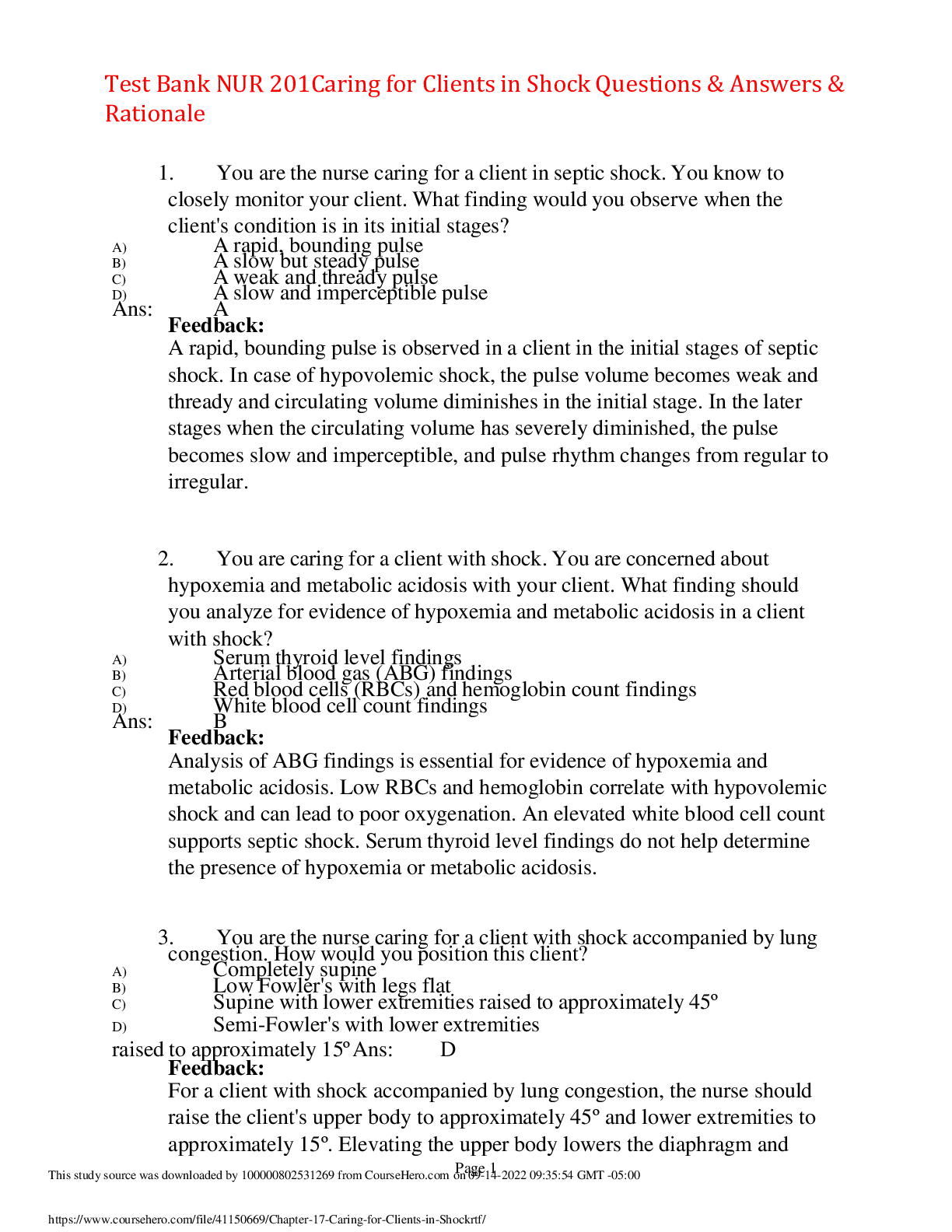
Reviews( 0 )
Document information
Connected school, study & course
About the document
Uploaded On
Sep 22, 2022
Number of pages
16
Written in
Additional information
This document has been written for:
Uploaded
Sep 22, 2022
Downloads
0
Views
30

